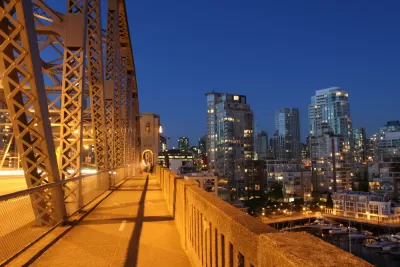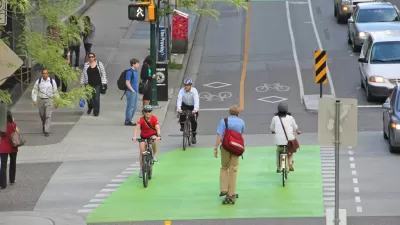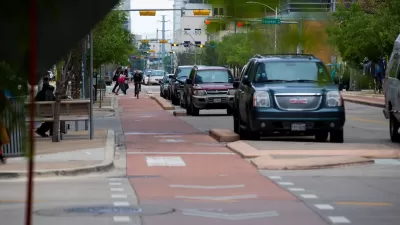Building protected bike lanes in Canada isn't as controversial as it once was. Maybe there's hope for the United States?

The Globe and Mail's editorial board dares to ask if the "war against bike lanes" is finally coming to end in Canada—with people on bikes emerging as the unlikely victor in this battle for public space.
The latest bike lane projects in Vancouver, under construction on Richard and Smithe streets on the city's downtown peninsula, moved forward without attracting controversy, , according to the editorial board—the opposite of bike lane projects in the late 2000s.
Take, for example, the opening of the city's first protected bike lane on the Burrard Bridge:
‘Chaos’ feared, blared one headline. “Doomed to failure,” opined a columnist. All that proved incorrect: The Burrard Bridge bike lane, billed as the busiest in North America, saw 1.4 million rides in 2020, 40 per cent more than its first full year a decade earlier.
The relative peace of the two latest projects in Vancouver tell a story that repeats all over the county, according to the editorial board:
Penticton, in the British Columbia Interior, this summer opened its Lake-to-Lake bike lane; it plans to invest $15-million over the next five years. Sarnia, Ont., is extending its bicycling network. In Halifax, about a third of a planned 57 kilometres of protected bike lanes is complete. It includes Hollis Street through the heart of the city. Montreal last November opened a long north-south route on Saint Denis Street as part of its Réseau express vélo network.
Toronto, spurred by the pandemic, has installed protected lanes across the city. One new segment on Bloor Street East opened in late September. These lanes are billed as temporary, but it would be a short-sighted mistake to reverse course.
What was once a "political flashpoint" and an "ideological signifier" is now "standard-issue" civic infrastructure.
FULL STORY: Is the war against bike lanes finally over?

Study: Maui’s Plan to Convert Vacation Rentals to Long-Term Housing Could Cause Nearly $1 Billion Economic Loss
The plan would reduce visitor accommodation by 25,% resulting in 1,900 jobs lost.

North Texas Transit Leaders Tout Benefits of TOD for Growing Region
At a summit focused on transit-oriented development, policymakers discussed how North Texas’ expanded light rail system can serve as a tool for economic growth.

Alabama: Trump Terminates Settlements for Black Communities Harmed By Raw Sewage
Trump deemed the landmark civil rights agreement “illegal DEI and environmental justice policy.”

How Community Science Connects People, Parks, and Biodiversity
Community science engages people of all backgrounds in documenting local biodiversity, strengthening connections to nature, and contributing to global efforts like the City Nature Challenge to build a more inclusive and resilient future.

Alabama: Trump Terminates Settlements for Black Communities Harmed By Raw Sewage
Trump deemed the landmark civil rights agreement “illegal DEI and environmental justice policy.”

Dear Tesla Driver: “It’s not You, It’s Him.”
Amidst a booming bumper sticker industry, one writer offers solace to those asking, “Does this car make me look fascist?”
Urban Design for Planners 1: Software Tools
This six-course series explores essential urban design concepts using open source software and equips planners with the tools they need to participate fully in the urban design process.
Planning for Universal Design
Learn the tools for implementing Universal Design in planning regulations.
City of Santa Clarita
Ascent Environmental
Institute for Housing and Urban Development Studies (IHS)
City of Grandview
Harvard GSD Executive Education
Toledo-Lucas County Plan Commissions
Salt Lake City
NYU Wagner Graduate School of Public Service





























